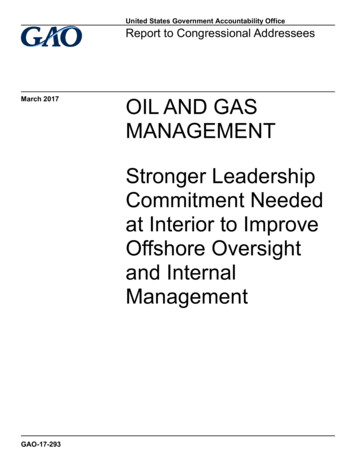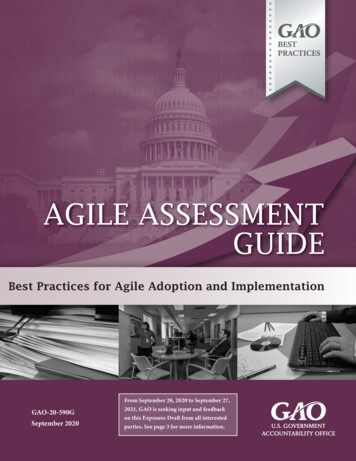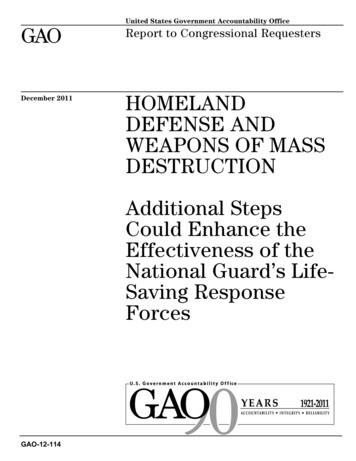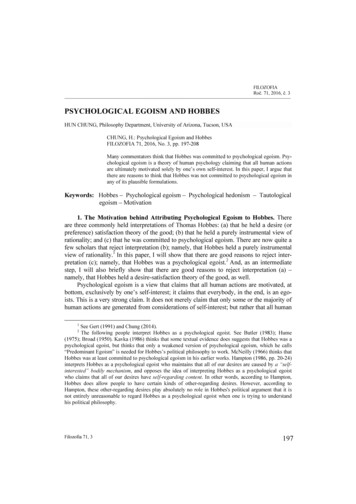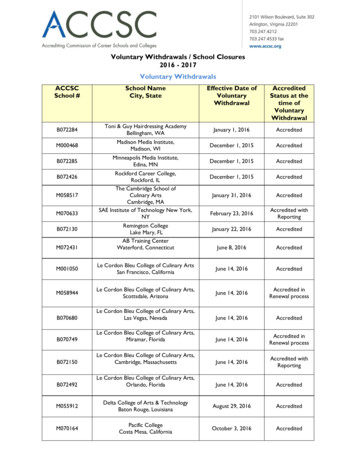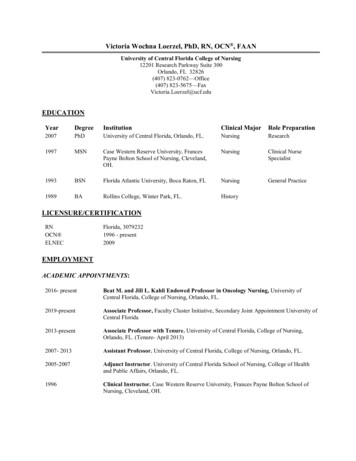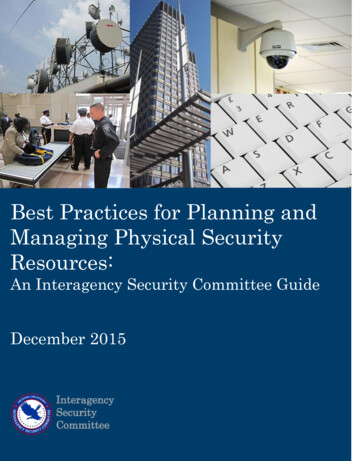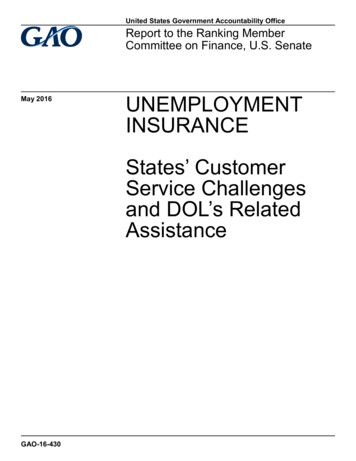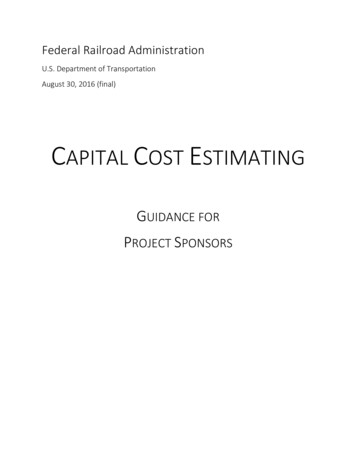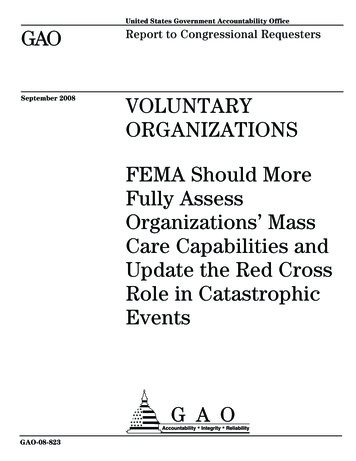
Transcription
United States Government Accountability OfficeGAOReport to Congressional RequestersSeptember 2008VOLUNTARYORGANIZATIONSFEMA Should MoreFully AssessOrganizations’ MassCare Capabilities andUpdate the Red CrossRole in CatastrophicEventsGAO-08-823
September 2008VOLUNTARY ORGANIZATIONSAccountability Integrity ReliabilityHighlightsHighlights of GAO-08-823, a report tocongressional requestersFEMA Should More Fully Assess Organizations’ MassCare Capabilities and Update the Red Cross Role inCatastrophic EventsWhy GAO Did This StudyWhat GAO FoundVoluntary organizations havetraditionally played a major role inthe nation’s response to disasters,but the response to HurricaneKatrina raised concerns about theirability to handle large-scaledisasters. This report examines (1)the roles of five voluntaryorganizations in providing masscare and other services, (2) thesteps they have taken to improveservice delivery, (3) their currentcapabilities for responding to masscare needs, and (4) the challengesthey face in preparing for largescale disasters. To address thesequestions, GAO reviewed theAmerican Red Cross, The SalvationArmy, the Southern BaptistConvention, Catholic CharitiesUSA, and United Way of America;interviewed officials from theseorganizations and the FederalEmergency Management Agency(FEMA); reviewed data and laws;and visited four high-risk metroareas—Los Angeles, Miami, NewYork, and Washington, D.C.The five voluntary organizations we reviewed are highly diverse in their focusand response structures. They also constitute a major source of the nation’smass care and related disaster services and are integrated into the 2008National Response Framework. The Red Cross in particular—the only onewhose core mission is disaster response—has a federally designated supportrole to government under the mass care provision of this Framework. Whilethe Red Cross no longer serves as the primary agency for coordinatinggovernment mass care services—as under the earlier 2004 National Plan—it isexpected to support FEMA by providing staff and expertise, among otherthings. FEMA and the Red Cross agree on the Red Cross’s role in acatastrophic disaster, but it is not clearly documented. While FEMArecognized the need to update the 2006 Catastrophic Incident Supplement toconform with the Framework, it does not yet have a time frame for doing so.What GAO RecommendsGAO recommends that FEMAupdate and document the RedCross’s role in a catastrophic event,take steps to incorporate voluntaryorganizations’ capabilities in itsassessments, and clarify fundingguidance for certain disasterpreparedness grants. Incommenting on the draft report,FEMA agreed with tworecommendations, but disagreedwith the recommendation to betterincorporate voluntaryorganizations in assessments. Wecontinue to believe such efforts areimportant for preparedness.To view the full product, including the scopeand methodology, click on GAO-08-823.For more information, contact CynthiaFagnoni at (202) 512-7215 orfagnonic@gao.gov.Since Katrina, the organizations we studied have taken steps to strengthentheir service delivery by expanding coverage and upgrading their logisticaland communications systems. The Red Cross, in particular, is realigning itsregional chapters to better support its local chapters and improve efficiencyand establishing new partnerships with local community-based organizations.Most recently, however, a budget shortfall has prompted the organization toreduce staff and alter its approach to supporting FEMA and state emergencymanagement agencies. While Red Cross officials maintain that these changeswill not affect improvements to its mass care service infrastructure, it has alsorecently requested federal funding for its governmental responsibilities.Capabilities assessments are preliminary, but current evidence suggests thatin a worst-case large-scale disaster, the projected need for mass care serviceswould far exceed the capabilities of these voluntary organizations withoutgovernment and other assistance—despite voluntary organizations’substantial resources locally and nationally. Voluntary organizations alsofaced shortages in trained volunteers, as well as other limitations that affectedtheir mass care capabilities. Meanwhile, FEMA’s initial assessment does notnecessarily include the sheltering capabilities of many voluntary organizationsand does not yet address feeding capabilities outside of shelters. In addition,the ability to assess mass care capabilities and coordinate in disasters iscurrently hindered by a lack of standard terminology and measures for masscare resources, and efforts are under way to develop such standards.Finding and training more personnel, dedicating more resources topreparedness, and working more closely with local governments are ongoingchallenges for voluntary organizations. A shortage of staff and volunteers wasmost commonly cited, but we also found they had difficulty seeking anddedicating funds for preparedness, in part because of competing priorities.However, the guidance for FEMA preparedness grants to states and localitieswas also not sufficiently explicit with regard to using such funds to supportthe efforts of voluntary organizations.United States Government Accountability Office
ContentsLetter1Results in BriefBackgroundVoluntary Organizations Are a Major Source of Mass Care andOther Services in Disasters and Have Significant Support Rolesunder the National Response FrameworkVoluntary Organizations Have Taken Steps to Expand Coverageand Strengthen Their Service Delivery StructuresAlthough Early Assessments Are Limited, a Worst-Case Large-ScaleDisaster Would Likely Overwhelm the Current Ability of MajorVoluntary Organizations to Provide Mass Care in Four MetroLocations without Government and Other AssistanceShortages in Personnel, Preparedness Funding, and Connections toGovernment Remain a ChallengeConclusionsRecommendations for Executive ActionAgency Comments and Our Evaluation50565859Appendix IObjectives, Scope, and Methodology64Appendix IINVOAD Members68Appendix IIIComments from DHS70Appendix IVAmerican Red Cross77Appendix VGAO Contact and Staff Acknowledgments80Bibliography3715283581Page iGAO-08-823 Voluntary Organizations in Disasters
GAO Related Products82TablesTable 1: Disaster-Related Services Provided by the Five VoluntaryOrganizations In Our ReviewTable 2: Disaster Services Provided during and after the Gulf CoastHurricanesTable 3: Voluntary Organizations’ National Office DisasterResponse Functions in Large-Scale DisastersTable 4: Voluntary Organizations’ Regional and Local ResponseStructuresTable 5: Current and Ongoing Assessments of Disaster ResponseCapabilities by FEMA and the Red CrossTable 6: Examples of Federal and Other Estimates of theMagnitude of Mass Care Needs in Worst-Case Large-ScaleDisastersTable 7: Shelters Operated by the American Red Cross andPotential Capacity in Four Metropolitan Areas16181920374244FiguresFigure 1: Federal Framework for National Response to Large-ScaleDisastersFigure 2: Voluntary Organizations, Governments, and PrivateSector Roles under the National Response FrameworkFigure 3: Red Cross Role under the National Response FrameworkFigure 4: Voluntary Organizations’ Scaling Up Process in LargeScale DisastersPage ii10122436GAO-08-823 Voluntary Organizations in Disasters
OADCoordinated Assistance NetworkDepartment of Homeland SecurityEmergency Support Function 6—Mass Care, EmergencyAssistance, Housing and Human Services AnnexFederal Emergency Management AgencyGap Analysis Programmeal ready-to-eatNational Incident Management SystemNational Voluntary Organizations Active in DisasterNational Response Frameworkvoluntary agency liaisonVoluntary Organizations Active in DisasterThis is a work of the U.S. government and is not subject to copyright protection in theUnited States. The published product may be reproduced and distributed in its entiretywithout further permission from GAO. However, because this work may containcopyrighted images or other material, permission from the copyright holder may benecessary if you wish to reproduce this material separately.Page iiiGAO-08-823 Voluntary Organizations in Disasters
United States Government Accountability OfficeWashington, DC 20548September 18, 2008Congressional Requesters:Voluntary organizations have long played a critical role in providing careto people affected by emergencies or natural disasters—no more so thanin the aftermath of Hurricanes Katrina and Rita in 2005. Recently, thecatastrophic loss of life from a major cyclone in Burma was also a soberreminder of the need for such organizations. In the United States,hundreds of voluntary organizations, most often locally or regionallybased, routinely assist disaster victims with mass sheltering and feedingand other services. Among those able to provide resources nationally arethe American Red Cross, The Salvation Army, the Southern BaptistConvention, Catholic Charities, and the United Way. In terms of funding,alone, following the 2005 hurricanes, the Red Cross raised more than 2.1billion; The Salvation Army, 325 million; Catholic Charities USA, 150million; the United Way, 28 million; and the Southern Baptist Convention,about 20 million.While our nation’s voluntary organizations have been critical complementsto local, state, and federal government agencies during disasters, themagnitude of the September 11, 2001, terrorist attack and HurricaneKatrina, in particular, revealed the need to further build a national systemof emergency management that better integrates voluntary agencies’efforts and capabilities. A national blueprint for such a system thatcoordinates voluntary, government, and private sector responders isoutlined by the Department of Homeland Security’s (DHS) 2008 NationalResponse Framework (the Framework). National planning has been acomplex process on many fronts—local, state, and federal government,and private—and many questions arise in the process. In particularCongress and others have raised concerns regarding the capabilities ofvoluntary organizations, in support of governments, to provide mass careand other assistance when there is a large-scale disaster. To provideinsight into the readiness of these organizations to respond to large-scaledisasters requiring a federal response, we examined the followingquestions:1. What are the roles of major national voluntary organizations inproviding mass care and other human services in response to largescale disasters requiring federal assistance?Page 1GAO-08-823 Voluntary Organizations in Disasters
2. What steps have these organizations taken since Katrina to strengthentheir capacity for service delivery?3. What is known about their current capabilities for responding to masscare needs in such a large-scale disaster?4. What are the remaining challenges that confront voluntaryorganizations in preparing for such large-scale disasters?Overall, to address these objectives, we reviewed federal and voluntaryorganization documents; conducted site visits; interviewed local, state, andnational governmental and voluntary agency officials; and reviewedrelevant laws. More specifically, we reviewed governmental and otherreports on the lessons learned from the response to Hurricane Katrina aswell as key federal disaster management documents, including the 2008National Response Framework; the Catastrophic Incident Supplement tothe Framework, which describes the federal government’s detailedstrategy for coordinating a national response to a catastrophic disaster;and Emergency Support Function 6—Mass Care, Emergency Assistance,Housing, and Human Services Annex (ESF-6), which together describe thefederal coordination of the delivery of federal mass care and other humanservices. We also interviewed officials from the Federal EmergencyManagement Agency (FEMA)—a federal agency within DHS that is thelead agency for responding to disasters. For five major voluntaryorganizations—the Red Cross, The Salvation Army, the Southern BaptistConvention, Catholic Charities USA, and United Way of America—wereviewed documents including their disaster response plans,memorandums of agreement, and various data, such as data on sheltersand other mass care resources. We also interviewed voluntaryorganization officials at their national headquarters as well as the Directorof the National Voluntary Organizations Active in Disaster (NVOAD), anumbrella group of nationwide nonprofit organizations. To examinevoluntary organizations’ capabilities—especially in mass care—weconducted site visits to four metropolitan areas considered at high risk fordifferent types of disasters, such as major earthquakes, hurricanes, orterrorist attacks: (1) Los Angeles, California; (2) Miami, Florida; (3) NewYork City, New York; and (4) Washington D.C. For each of these areas, wereviewed documents and obtained available data from the voluntaryorganizations on their sheltering and feeding capabilities. We alsointerviewed officials from the selected voluntary organizations; local andstate government emergency management agencies; NVOAD’s localaffiliates, known as Voluntary Organizations Active in Disaster (VOAD);and FEMA’s regionally based liaisons to the voluntary sector, known asvoluntary agency liaisons. In discussing voluntary organizations’Page 2GAO-08-823 Voluntary Organizations in Disasters
capabilities in this report, we do not attempt to assess the total disasterresponse capabilities in any single location that we visited or the efficacyof any responses to particular scenarios, such as major earthquakes versushurricanes. We conducted this performance audit from August 2007 toSeptember 2008 in accordance with generally accepted governmentauditing standards. Those standards require that we plan and perform theaudit to obtain sufficient, appropriate evidence to provide a reasonablebasis for our findings and conclusions based on our audit objectives. Webelieve that the evidence obtained provides a reasonable basis for ourfindings and conclusions based on our audit objectives. See appendix I formore information on our scope and methodology.Results in BriefThe voluntary organizations in our review are a major source of mass careand other services in large-scale disasters and play key roles in nationalresponse, in coordination with local, state, and federal governments, underthe National Response Framework. Four of these organizations provide avariety of services such as mass care feeding, case management, andcleanup, while the fifth—the United Way—mostly conducts fund-raisingfor other organizations. The organizations’ response structures also vary,from more centralized, with a high level of authority at the national level,to more decentralized, in which local units are autonomous. Most of theorganizations coordinate their services with each other and governmentsat various levels through formal written agreements and equally importantinformal working relationships. The newly issued National ResponseFramework recognizes the importance of voluntary organizations indisaster response and specifically designates the American Red Cross asone of the support agencies for the mass care functions of ESF-6. Thissupport role represents a change from the Red Cross’s role in the earliernational plan as the primary agency for mass care, because FEMA and theRed Cross agreed that the Red Cross—as a nongovernmental entity—cannot legally direct federal resources. Recently, in response to a majorbudget deficit, the Red Cross made staffing cuts and other changes in itsoperations and also sought federal funding to assist it with the cost of itssupport agency responsibilities under the Framework. The CatastrophicIncident Supplement to the Framework, which describes the federal visionof the national response to a catastrophic disaster, still characterizes theRed Cross as the primary agency for mass care, although both FEMA andRed Cross officials agreed that the Red Cross would serve as a supportagency in accordance with the more recent ESF-6 role change. FEMA andRed Cross officials also agreed that the Red Cross would continue toprovide mass care services in a catastrophic disaster, acting as a privateservice provider, regardless of any future revisions to this Supplement.While FEMA is revising an annex to the Framework on catastrophicPage 3GAO-08-823 Voluntary Organizations in Disasters
incidents, according to agency officials, it does not currently have a timeframe for revising the more detailed, operationally specific Supplement,although agency officials said they are in the process of establishing areview timeline. Although the Red Cross and FEMA told us that theyunderstand the Red Cross’s role as a support agency in a catastrophicevent, there is no interim agreement documenting these expectations.In response to weaknesses evident during Katrina, the four direct serviceproviders in our review—Red Cross, The Salvation Army, the SouthernBaptist Convention, and Catholic Charities—have taken steps tostrengthen their service delivery by expanding service coverage andimproving collaboration with each other on services, logistics, andcommunications. To address its gaps in service coverage, the Red Cross isin the process of implementing two main strategies: reorganizing itschapters and developing stronger partnerships with local community andfaith-based organizations, particularly in rural areas with hard-to-reachpopulations. According to Red Cross officials, these initiatives areexpected to improve service delivery while expanding services tocommunities that do not have established Red Cross chapters. While theRed Cross has made staffing cuts and other changes in response to itsbudget deficit, Red Cross officials reported that these service deliveryinitiatives would continue; nevertheless, the effect of these changesremains to be seen. Meanwhile, the national and four local offices of thedirect service providers to varying degrees also strengthened their abilityto coordinate services by collaborating more on feeding and casemanagement and improving their logistical and communications systems.For example, to prevent future breakdowns in resource deployment andmanagement, the Red Cross, The Salvation Army, and the Southern BaptistConvention are working together to improve management of their supplychains.Initial assessments have not fully captured the collective capabilities ofmajor voluntary organizations; however, evidence suggests that withoutgovernment and other assistance, a worst-case large-scale disaster wouldoverwhelm voluntary organizations’ current sheltering and feedingcapabilities, according to voluntary organization officials and data wereviewed. The federal government and voluntary organizations in ourreview have started to identify mass care capabilities, but most existingassessments are locally or regionally based and do not provide a picture ofnationwide capabilities. For example, FEMA’s 2007 survey of disastercapabilities in selected states assesses sheltering but has not yet begun toaddress feeding capabilities outside of shelters. Moreover, it does notinclude all voluntary organization capabilities, since participating statesonly include information from organizations with which they have formalPage 4GAO-08-823 Voluntary Organizations in Disasters
agreements, according to FEMA officials. In the metro areas we visited,these agreements were generally limited to the Red Cross. Except for theRed Cross, the other voluntary organizations we reviewed have not yetassessed their own nationwide capabilities, and some do not use standardterms or measures for characterizing mobile kitchens and other disasterresources. In the four metro areas we visited, the Red Cross, The SalvationArmy, and the Southern Baptist Convention were able to provide data ontheir local sheltering and feeding resources, and they also report havingsubstantial nationwide resources that can be brought to bear in anaffected area for a large-scale disaster. Nevertheless, the need for masscare services in a worst-case large-scale disaster, as projected bygovernment and the Red Cross, would likely overwhelm their currentcapabilities, according to voluntary organization officials as well as ouranalysis. For example, a major earthquake in a metropolitan area couldnecessitate shelter for as many as 300,000 people, according to DHS, butRed Cross officials in Los Angeles—a city prone to earthquakes— told ustheir local sheltering capacity is 84,000 people under optimal conditions.Voluntary organization officials also said developing additional capabilityis constrained by the limited availability of personnel and other logisticalchallenges. In recognition of these challenges, local governments wevisited and FEMA officials told us they are planning to use governmentemployees and private sector resources to help address sheltering andfeeding needs. Red Cross and FEMA officials also told us that in acatastrophic situation, assistance will likely be provided from manysources, including the general public, as well as the private and nonprofitsectors, that are not part of any prepared or planned response.National and local voluntary organizations, including local VOADs, in ourstudy continue to face challenges in increasing the number of trainedpersonnel, identifying and dedicating financial resources for preparedness,and strengthening governmental links. Officials from these organizationstold us that they found it difficult to dedicate staff to planning andcoordination activities for future disasters. In addition, shortages oftrained mass care volunteers continue to be an ongoing concern despitethe efforts of voluntary organizations and government agencies to build acadre of trained personnel. Identifying and dedicating financial resourcesfor disaster planning and preparedness becomes increasingly difficult fororganizations in light of competing priorities. For example, while the RedCross raised more than 2 billion following Katrina, currently the RedCross commented that it has been difficult to raise public donations tosupport its capacity-building initiatives. Additionally, while DHSemergency preparedness grants are another potential source of suchfunding, voluntary organization officials told us they typically do notreceive funding from these grants. According to a senior official fromPage 5GAO-08-823 Voluntary Organizations in Disasters
FEMA’s grant office, FEMA considered voluntary organizations as amongthe eligible subgrantees for several emergency preparedness grants, butfederal guidance to states who distribute these grants did not clearlyindicate this. Finally, although the service providers in our review tooksteps to increase coordination with each other, coordination andinteraction with government agencies at all levels remain a challenge fororganizations we visited. While local VOADs in the areas we visited helpedvoluntary organizations coordinate with each other and local governmentagencies, the ability of these VOADs to effectively work with governmentagencies varied. For the Red Cross, it is too soon to tell how its recentstaffing cuts and other changes will affect its ability to coordinate withFEMA and state governments during disasters.In this report we are making recommendations to FEMA to update anddocument FEMA’s expectations for the Red Cross in a catastrophicdisaster, take steps to better incorporate voluntary organizations’capabilities into its assessments of mass care capabilities, and clarifystates’ ability to consider voluntary organizations and local VOADs asamong the potential recipients of federal preparedness funds. Incommenting on a draft of this report, FEMA agreed with ourrecommendations on establishing a time frame for updating the role of theAmerican Red Cross in the Catastrophic Incident Supplement andclarifying federal guidance to states on potential recipients ofpreparedness grants. However, FEMA criticized certain aspects of ourmethodology, asserting that the draft did not address the role of states incoordinating mass care. As stated in our objectives, the focus of ourreport, by design, is on voluntary organizations’ roles and capabilities indisaster response. While focusing on voluntary organizations, our draftreport also acknowledges the disaster response role and responsibilities ofgovernments—local, state, and federal—under the National ResponseFramework. Accordingly, we interviewed local, state, and federalgovernment emergency management officials, as described in the moredetailed description of our report’s methodology. FEMA also raisedconcerns about whether the voluntary organizations discussed in ourreport provided a comprehensive picture of mass care capabilities.However, our report does not attempt to address all the services andcapabilities of the voluntary sector but acknowledges that other voluntaryorganizations also provide mass care and other services. It also includesthe caveat that we do not attempt to assess the total disaster responsecapabilities in any single location we visited. FEMA also disagreed withour recommendation to better incorporate voluntary organizations’capabilities in assessments because the government cannot command andcontrol private sector resources. However, FEMA is required under thePost-Katrina Act to establish a comprehensive assessment system toPage 6GAO-08-823 Voluntary Organizations in Disasters
assess the nation’s prevention capabilities and overall preparedness. Acomprehensive assessment of the nation’s capabilities should account asfully as possible for voluntary organizations’ capabilities in mass care.Assessing capabilities more fully does not require controlling theseresources but rather cooperatively obtaining and sharing information.Without such an assessment, the government will have an incompletepicture of the mass care resources it can draw upon in large-scaledisasters. In its comments, FEMA also asserted that our report incorrectlyassumes that if funding was made available, it would enable voluntaryorganizations to shelter and care for people in catastrophic events.However, we discuss potential federal funding in relation to voluntaryorganizations’ preparedness and planning activities, not direct services.As noted in the report, such funding could be used to strengthen voluntaryorganizations’ disaster preparedness, such as coordination with FEMA,training of personnel, and developing continuity of operations plans.FEMA also provided some technical clarifications, which we incorporatedas appropriate.We also provided a draft of this report to the American Red Cross as wellas excerpts from the draft report, as appropriate, to The Salvation Army,the Southern Baptist Convention, Catholic Charities USA, and NVOAD. Inits comments, the Red Cross further explained its role in providing postevacuation sheltering under New York City’s coastal storm plan andprovided technical clarifications. We added information as appropriate tofurther clarify the American Red Cross’s role in providing sheltering inNew York City. In addition, the American Red Cross, The Salvation Army,and NVOAD provided us with technical comments, which we haveincorporated as appropriate.BackgroundState and local governments generally have the principal responsibility formeeting mass care and other needs in responding to a disaster; however,governments largely carry out this responsibility by relying on the servicesprovided by voluntary organizations. Voluntary organizations providesheltering, feeding, and other services, such as case management, todisaster victims and have long supported local, state, and federalgovernment responses to disasters.Voluntary Organizations inDisastersVoluntary organizations have historically played a critical role in providingservices to disaster victims, both on a routine basis—in response to housefires and local flooding, for example—and in response to far rarerPage 7GAO-08-823 Voluntary Organizations in Disasters
disasters such as devastating hurricanes or earthquakes.1 Their assistancecan vary from providing immediate services to being involved in long-termrecovery efforts, including fund-raising. Some are equipped to arrive at adisaster scene and provide immediate mass care, such as food, shelter, andclothing. Other charities address short-term needs, such as providing casemanagement services to help disaster victims obtain unemployment ormedical benefits. Other voluntary organizations provide long-term disasterassistance such as job training or temporary housing assistance for lowincome families. In addition, local organizations that do not typicallyprovide disaster services may step in to address specific needs, asoccurred when churches and other community organizations beganproviding sheltering after the Gulf Coast hurricanes.The American Red Cross, a nongovernmental organization founded in1881, is the largest of the nation’s mass care service providers. Operatingunder a congressional charter since 1900, the Red Cross providesvolunteer humanitarian assistance to the armed forces, serves as amedium of communication between the people of the United States andthe armed forces, and provides direct services to disaster victims,including feeding, sheltering, financial assistance, and emergency first aid.2An additional key player in the voluntary sector is NVOAD, an umbrellaorganization of nonprofits that are considered national in their scope.Established in 1970, NVOAD is not itself a service delivery organization butrather coordinates planning efforts by many voluntary organizationsresponding to disaster, including the five organizations in this review. Inaddition to its 49 member organizations, NVOAD also coordinates withchartered state Voluntary Organizations Active in Disaster (VOAD) andtheir local affiliates. (See app. II for NVOAD members.)The occurrence in 2005 of Hurricanes Katrin
the Red Cross no longer serves as the primary agency for coordinating government mass care services—as under the earlier 2004 National Plan—it is expected to support FEMA by providing staff and expertise, among other things. FEMA and the Red Cross agree on the Red Cross's role in a catastrophic disaster, but it is not clearly documented.


